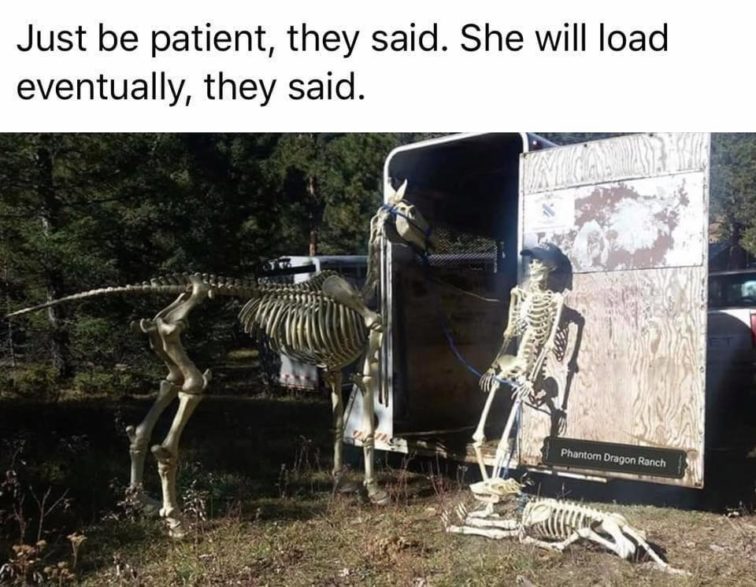We thank Neal Schaffer at Double D Trailers for sharing some important trailer loading tips.
You’ll probably need to use a trailer to transport your horse at some time. While some horses load onto trailers without incident, others get fearful and refuse to do so. We have put up this information because we know how irritating it can be when the horse refuses to load despite all of your attempts to convince them to do so.
How can a horse be made to load onto a trailer? By doing the following, you can make them load.
- Observe the necessary safety precautions when loading your horse.
- Desensitize your horse to the trailer’s other features, including its small compartments.
- To persuade the horse to board the trailer, employ simple groundwork techniques.
- Provide a positive experience for your horse as soon as they enter the trailer.
- Be constant in practicing getting your horse on the trailer.
If you just want to compete, go to competitions, or even take the pony to the vet if required, you’ll need to trailer your horse. You’ll avoid a lot of stress if you can securely put your horse onto a trailer, we know. For the above reason, here is the lifesaver Double D Trailers Safetack Reverse Living Quarters.
The Double D Trailers reversing horse trailer is a wiser choice, thanks to a number of important features. The Safetack Reverse Slant Load trailer aims at the shortcomings of everything other companies are doing. The main aim of the company was to build something that could actually be more relevant.

Designs for rear-facing trailers have been there for a while. Instead, the company applied a fresh layout and additional safety measures to an old concept. Most of these additional layouts also have side entrances, segregated stalls, and reverse slant load configurations.
The area in which the horse may escape the trailer is constrained by the tack storage room, which also decreases the lifting area for the back doors. The Double D Trailers design has an additional wall behind the back horse as another safety precaution. This divider keeps the horse from attempting to unload as soon as the trailer’s rear ramp is opened.
Drop-down glass on both sides of the horse trailer and overhead pop-up vents at the horse’s head and tail are features of the Safetack Reverse Slant design. As a result, owners can face their horses either rearward or forward without compromising accessibility or ventilation.
We have step-wise demonstrated the following actions to train horses to lift onto a trailer:
STEP 1: Make the appropriate safety preparations before loading your horse
There are various safety risks that you should be aware of while dealing with a horse to load properly on a trailer.
Always connect the trailer to a vehicle
Prior to trying to load your horse on the trailer, ensure it is constantly connected to a stationary vehicle. Horses may weigh up to one ton; therefore, if a trailer isn’t connected to a vehicle, the weight of a horse might easily cause the trailer to shift.
Respect your personal space
A horse may begin to disregard any degree of self boundaries you may have when they become agitated over a task you are asking them to complete. By being aware of this beforehand, you may perform groundwork activities to teach the horse to respect personal space.
When dealing with a horse and a trailer, keep yourself out of potentially hazardous situations
Once your horse is inside the trailer, these zones may include the space between both the horse and the trailer wall. Never enter the area; your horse might easily squash you or become frightened and badly hurt you.
Avoid standing immediately behind a trailer with a horse that isn’t restrained inside; the animal could escape and strike you by mistake. Always keep an eye on the horse’s whereabouts and stand to the side.
Know how your horse would respond in this circumstance
You may get ready and be safe in advance by being aware of how a horse that is hesitant to load into a trailer might behave. The most frequent movement we observe in horses trying to board a trailer is a backward run, or of the trailer or out from it. When working with your horse, be sure nobody is standing behind the trailer.
As you guide the horse onto the trailer, exercise caution since the animal might jump on and unintentionally knock you down. By training your horse to self-load, you may avoid danger.
Before tying your horse up, be always sure to lock the panels or door of the trailer.
You are creating a very severe and hazardous scenario if the horse is restrained, yet there is no barrier to prevent them from backing out and stepping off the trailer. Always lock that rear panel or door before putting your horse up to prevent this.
STEP 2: Work on desensitizing the horse to confined spaces
It might be simpler for your horse to endure the entire process if you take the time to get your horse ready for loading onto the trailer. You may give the horse greater confidence during loading by acclimating them to confined areas beforehand, as well as by moving up and backing off of anything. Try the following exercises as a warm-up:
Create Difficult Obstacles to Surmount
The cramped and small area that a horse trailer offers may be the reason why the horse is hesitant to board it. Since horses are predatory animals, feeling confined, as in a trailer, may undoubtedly cause them to go into flight mode. Desensitize your horse to restricted spaces to help him feel more comfortable in the trailer.
Create tight-space challenges first; it is suggested to frequently construct a tiny funnel using ground poles or two barrels placed side by side for walking through. Simply getting the horse acclimated to these confined spaces is the main objective here.
Practice getting your horse to step onto and off of a cliff or slope
Your horse would enter the trailer without difficulty, but pulling out of it would be a major hassle. The horse might develop a fear of backing up the trailer as a result. You wouldn’t believe how many horses there are that are like this.
We’ve found that practicing sliding the horse down a descent, such as a little hill, is a fantastic exercise to fight this. It will feel like backing down a ramp when you do this. Train backing off of tiny cliffs or perhaps even stakes on the ground if your trailer doesn’t have a ramp. The horse will be more comfortable when the trailer is backed off in this manner. After some practice, many were able to back their horse out of the trailer with ease.

STEP 3: Encourage The Horse to Board the Trailer Using Simple Groundwork
Groundwork Suggestions for Novice Riders
Before we continue, we want to stress the importance of maintaining calm when working with the horse and the trailer. If you get impatient and put your horse in a stressful situation, the horse may become resistant to loading onto the trailer.
When loading your horse, pressure and release are the basic foundations you’ll utilize most frequently. A training method is known as “pressure and release” teaches horses how to respond appropriately by releasing pressure. For instance, you could exert pressure on the lead if you want your horse to advance. We’ll let off the strain after the horse moves forward appropriately in response. If the horse rejects or resists the pressure, we’ll keep applying it until the horse reacts in some way. We’ll next demonstrate how to apply this idea while loading your horse onto the trailer.
Getting Close to the Trailer
The first thing you’ll do is confidently and assertively bring the horse up to the trailer.
The more assured you are, the more assured the horse will be. Encourage the horse to move forward if it hesitates; if it begins to back away, stay still and command the animal to come back up to you. Hold the pressure while escalating it gradually until they comply.
Reward Even the Tiniest Forward Progress
You can let the horse relax and stand for a while if they seem a little more confident about approaching the trailer. It might not first appear as though the horse is loading the trailer. The horse can only appear to be placing one of its front feet inside the trailer. Release any force you may be using as immediately as they accomplish this, and then give your horse some praise.
If your horse is wary of reaching the trailer, remember to praise him or her for even the smallest forward movement.
Regularly Give Your Horse Breaks
Give your regular horse breaks, and don’t put too much pressure on them when loading them onto the trailer, if you want them to enjoy this experience. Making horses focus for extended amounts of time on something they might become angry with can be demanding because they can only focus for around 20 seconds at a time. Instead, take breaks for your horse every few minutes as you work them with the trailer. This might serve as a motivational tool for approaching or boarding the trailer.
A break entails briefly leaving the trailer and simply guiding the horse about. Never do this unless the horse yields to pressure appropriately. Whenever the horse is resisting you and applying pressure, taking a pause will actually encourage the animal to behave in that manner.
The groundwork phase of teaching a horse is regarded as its core. Check out some Foundation Exercises for Your Horse if you’d like to learn some fundamental groundwork methods.
Step 4: Make a positive experience for your horse
It’s crucial that you make absolutely sure your horse enjoys every moment inside the trailer in order to help them develop positive associations with it.
Give them a trailer to rest in after their shift
Your goal is for your horse to see loading up on the horse trailer positively. This suggests you to underline that boarding the trailer equals a well-earned nap and a sense of accomplishment. You must give them all the praise you can muster once the horse is in the trailer and let it know it’s doing well.
Remember that it is a significant improvement if your horse is very reluctant to board the trailer. Don’t take any actions that might fast reverse this progress and force youto start over. Simply because your horse was first frightened of the trailer does not warrant rushing them or being irritated with them.
Show them that it’s fun to be on the trailer
As per the horse owners, when their horse found out it would be riding in the trailer, the pony used to become very happy. As soon as it started moving in the direction of the trailer, it would simply get aboard and take a seat by itself. Why do the horses act this way? She was aware that within was a lovely, fully-filled hay net. Horses enjoy eating, and often they prefer the locations where they are fed. You may make your horse feel completely at home by just having them stay on the trailer and munch hay.

Since horses are pack animals, they naturally like to be among other horses. Put other horses on the trailer with yours so that it becomes a familiar place for your horse. Pick a horse that is accustomed to riding on trailers and won’t cause a scene. Your horse will stay relaxed thanks to its composed temperament.
Horses learn by consistency, so if you utilize the trailer frequently, that’s only reasonable for them to become accustomed to it. Although it can seem like a pain, this is actually a lot of fun. You can start attending events, outings, and off-site trail trips after you can load your horse onto the trailer. Every weekend, you should trailer your horse away from the ranch.
Never forget that horses require consistency in order to comprehend what you are asking of them. Be persistent in your training techniques and the commands you give the horse. Your horse will be better able to respond to your signals as a result of this.
References:
- Horse Trailering Tips, November 2014. Meadows, D. and Henton, J. eXtension.
- Knot Tying: Quick Release Slip Knot, February 2015. eXtension.
- Basic Horse Safety Manual. American Youth Horse Council in Cooperation with the American Horse Council. 1989.
- Dehydration, stress, and water consumption of horses during long-distance commercial transport. 2000. Friend, T.H. Journal of Animal Science 78:2568–2580

